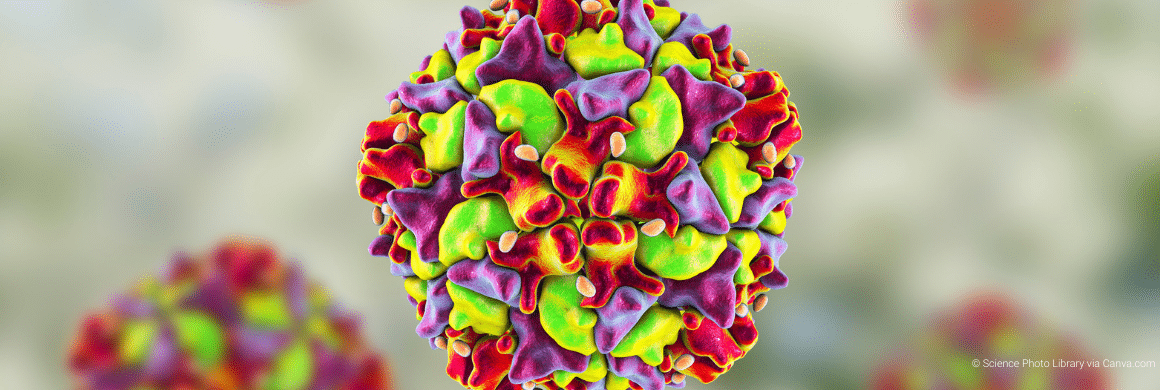It’s happening more and more. Measles outbreaks are in the news on what seems like a daily basis. As measles cases creep up across the country, Coloradans should look at their immunization records to ensure they’re adequately protected against measles and all other vaccine-preventable diseases (VPDs). Vaccines only work to prevent disease spread when enough people in a community have been vaccinated. While measles reigns supreme in today’s headlines, we could easily see headlines with mentions of outbreaks of other VPDs. Let’s turn our attention today to polio, another serious disease once common in the U.S. that still exists in some parts of the world.
What is polio?
Polio is a very contagious virus. Some people who get polio have no symptoms at all. For others, infection can lead to paralysis and even death. Those who do survive an initial polio infection may develop new symptoms like muscle weakness, joint and muscle pain, and fatigue years later. This is known as post-polio syndrome (PPS). Polio is mainly spread through fecal-oral contamination when a person comes into contact with the stool from an infected person or a contaminated object. The virus replicates in the intestinal tract. From there, it can enter the bloodstream and infect the brain and spinal cord. There is no cure for polio. Vaccination is the only protection we have against polio.
Polio vaccines and the fight to end polio
In 1979, polio was eliminated from the United States. Worldwide, cases of wild polio have decreased by 99% since 1988 when there were 350,000 cases in 125 countries; in 2022, there were only 30 cases in 3 countries. This is attributed to the powerful impact of high vaccine uptake. In July 2022, the U.S. saw its first case of polio since 2013. An unvaccinated individual from New York contracted a form of polio that can be traced to the live, weakened oral polio vaccine.
The oral polio vaccine (OPV) uses a weakened version of the poliovirus. OPV has not been used in the United States since 2000. We use the inactivated (or dead) polio vaccine (IPV) developed by Jonas Salk in 1955. In other parts of the world where wild polio is still regularly occurring, the oral polio vaccine is still used since it can be easily administered and does not require an injection. Neither IPV nor OPV can cause wild polio. However, the virus used in OPV can be excreted in feces and spread to others, especially in areas with poor hygiene and low vaccination coverage. If it circulates enough, it can, in very rare cases, mutate and genetically change into a form of vaccine-derived polio that can cause paralysis. The 2022 New York case was this type of vaccine-derived paralytic polio. People who have been vaccinated against polio are not at risk for vaccine-derived polio. The best way to protect against wild and vaccine-derived polio is to get vaccinated!
Being unvaccinated comes with risks
Since polio is still present in other parts of the world, travelers can transmit it and bring it to our communities. When that happens, unvaccinated people become vulnerable to infection. We’ve seen drops in routine immunizations since the COVID-19 pandemic. In Colorado, 1 in 5 children is missing vaccines. All Coloradans, especially children, deserve to live healthy lives where they can thrive without the worry of preventable diseases.
The polio vaccine is very safe and, like all other vaccines, it undergoes continuous monitoring. Vaccination against polio may cause pain and redness at the injection site. Infection from polio may cause sore throat, fever, stomach pain, vomiting, stiff neck, headache, paralysis, or even death. The benefits of vaccination far outweigh the risks! It is recommended that four doses of IPV are given: one dose each at 2, 4, and 6 – 18 months of age, and a fourth dose at 4 – 6 years of age. If your child needs the polio vaccine or other vaccines, talk with their provider about getting caught up. It’s up to all of us to ensure we don’t see headlines and the impact of preventable disease outbreaks in Colorado!
Immunize Colorado was formed in 1991 in response to alarmingly low vaccination rates across the state. At the time, only about 50% of Colorado’s children were adequately vaccinated. A group of physicians and other concerned individuals came together to strategize how to protect Coloradans from vaccine-preventable diseases and increase vaccine uptake. Much work remains. Discover ways to support our commitment to healthy Colorado communities or make a donation today!

